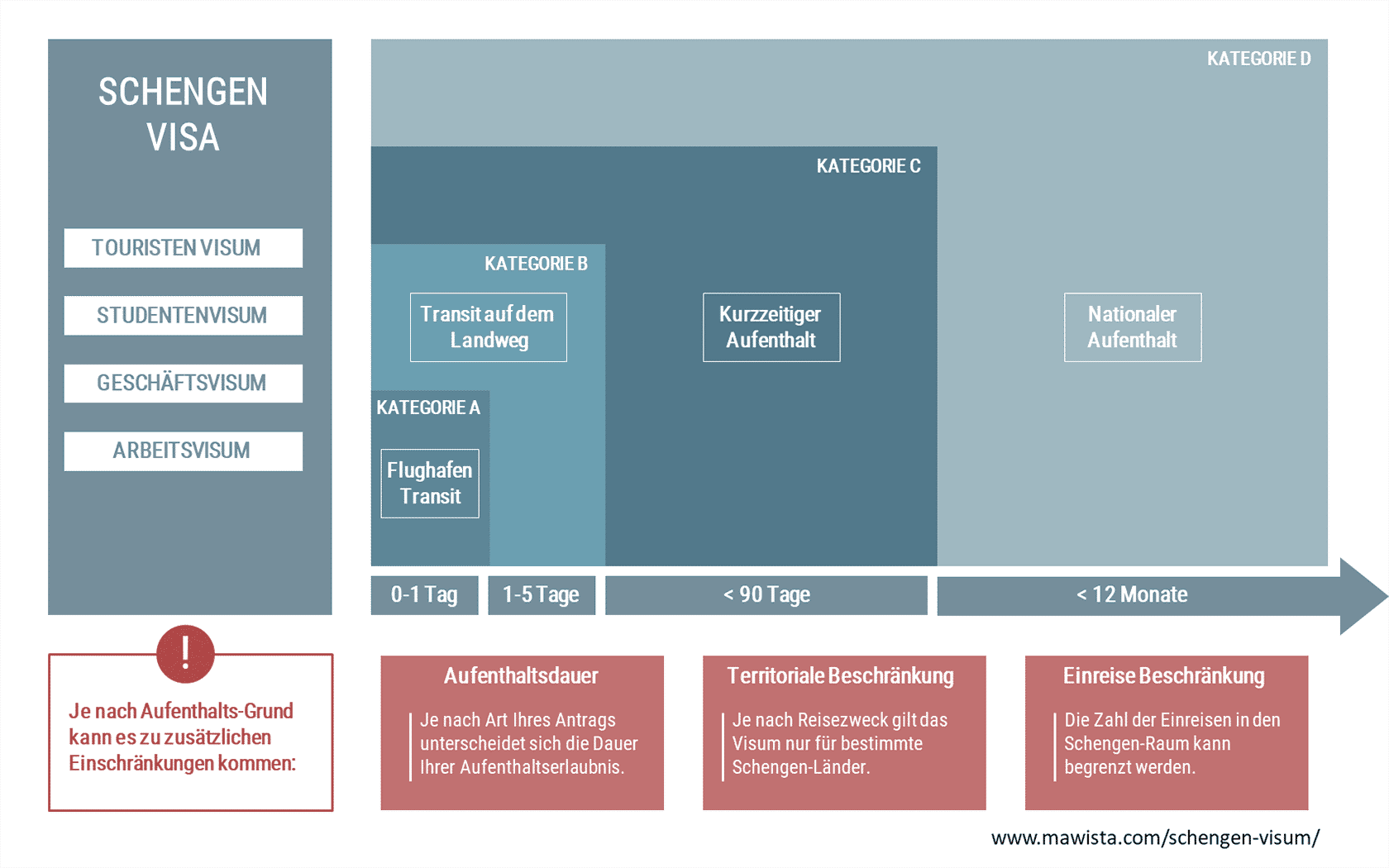Schengen Visa Categories
Depending on the purpose of the trip, there are different requirements for the permission to stay (e.g., duration or other authorizations). There are three categories of the Schengen visa (A, C, D).
Home Schengen Visa Schengen Visa Categories
Overview of Visa Categories
Category A
DaThe airport transit visa (A) entitles you to stay in the transit area of the airport.
Category C
The Schengen visa (C) allows entry and stay in the Schengen area for up to 90 days.
Category D
The National Visa (D) entitles you to a long-term stay in a specific Schengen country.
The National Visa (D) entitles you to a long-term stay in a specific Schengen country.
The following graphic illustrates the relationship between the visa categories (A, B, C, D) and the lengths of stay. The reason for your visa application is also decisive. Special permits (e.g., work permit, multiple entry) and restrictions (such as local limitations) are also noted in the visa in writing.
Category A: Airport Transit Visa
An airport transit visa is not required if:
- The traveller does not leave the international transit area of the airport and the final destination is outside the Schengen area
- You are holder of a valid visa or national residence permit of an EU or Schengen state sin
- You are the holder of a national residence permit for the following states: Andorra, Japan, Canada, San Marino or USA
- You hold a valid visa for the following states: Japan, Canada, USA
- You are a close family member of an EU citizen: Spouse / legal partner, children, grandchildren under the age of 21, parents, grandparents (if they are supported by the EU citizen)
Category B: Transit Visa (Overland)
Since the Visa Code came into force, transit visa (B) is now covered by the Schengen general visa (C). Originally, the B visa allowed one to cross the Schengen area by land in a maximum of 5 days.
Category C: Short-Term Visa
The Schengen visa (C) allows a short stay in the Schengen area for a maximum of 90 days within a 6-month period. The 90-day period begins on the day of entry.
Examples
- You arrive on the 1st of March in the Schengen area. This means that the 90-day period expires on May 29 and you leave the Schengen area. A new entry is only possible after the 180-day period (6 months) on August 27th.
- You enter the Schengen area on the 1st of March and fly back to your home country within 14 days. During the next 166 days you could theoretically spend 76 more days in the Schengen area (provided your visa allows multiple entry)
Attention!
Explanation:
If the visa only allows a stay of 7 days, the departure must take place within these 7 days. If the visa applies for a longer period, e.g., 2 years, the regulation described (90 days stay per 6 months) is valid for the entire period.
Category D: long-term “National Visa”
The national long-term visa (D) is always tied to a specific Schengen state. The permission to stay is issued for a maximum of 12 months. For all other Schengen countries, the usual 90-day rule applies, provided that no territorial restriction is specified in the visa.
- Language learners or students participating in educational programs
- Academicians for educational occupations or activities (+ family)
- Scientists for research purposes (+ family)
- Professionals for the purpose of practicing their profession (e.g., athletes)
- People in exceptional situations (for example, illness-related emergency)
Attention!
The national Schengen visa category D often only allows a one-time entry into the Schengen area. If you interrupt your stay in the meantime, you will not be able to enter the area again.
Good to Know
A national visa (D) may be extended if the reason for the stay so requires. The application for renewal must necessarily be made before expiry of the original visa at the local immigration office.





